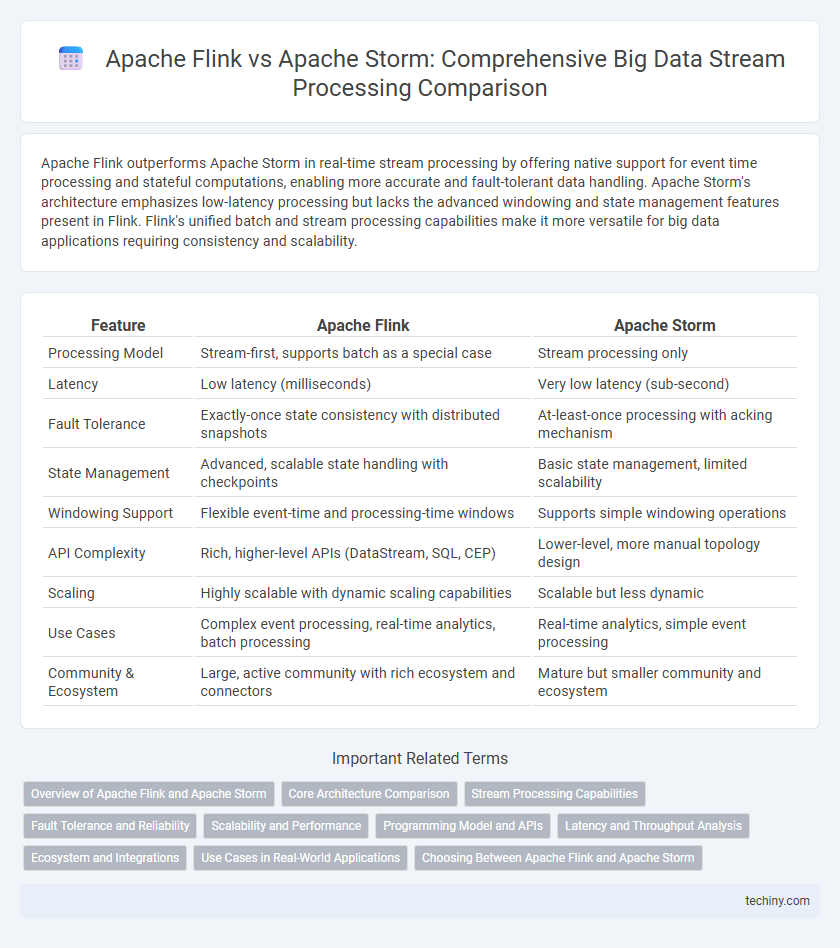Apache Flink outperforms Apache Storm in real-time stream processing by offering native support for event time processing and stateful computations, enabling more accurate and fault-tolerant data handling. Apache Storm's architecture emphasizes low-latency processing but lacks the advanced windowing and state management features present in Flink. Flink's unified batch and stream processing capabilities make it more versatile for big data applications requiring consistency and scalability.
Table of Comparison
| Feature | Apache Flink | Apache Storm |
|---|---|---|
| Processing Model | Stream-first, supports batch as a special case | Stream processing only |
| Latency | Low latency (milliseconds) | Very low latency (sub-second) |
| Fault Tolerance | Exactly-once state consistency with distributed snapshots | At-least-once processing with acking mechanism |
| State Management | Advanced, scalable state handling with checkpoints | Basic state management, limited scalability |
| Windowing Support | Flexible event-time and processing-time windows | Supports simple windowing operations |
| API Complexity | Rich, higher-level APIs (DataStream, SQL, CEP) | Lower-level, more manual topology design |
| Scaling | Highly scalable with dynamic scaling capabilities | Scalable but less dynamic |
| Use Cases | Complex event processing, real-time analytics, batch processing | Real-time analytics, simple event processing |
| Community & Ecosystem | Large, active community with rich ecosystem and connectors | Mature but smaller community and ecosystem |
Overview of Apache Flink and Apache Storm
Apache Flink is an open-source stream processing framework designed for high-throughput, low-latency, and stateful computations on unbounded data streams, supporting event time processing and complex event-driven applications. Apache Storm provides real-time stream processing with a distributed architecture focused on processing unbounded streams of data with strong fault tolerance and scalability features. Both frameworks support scalable, fault-tolerant stream processing but differ in processing models, with Flink excelling in state management and event time handling, while Storm emphasizes simplicity and low-latency processing.
Core Architecture Comparison
Apache Flink's core architecture is built around a distributed streaming dataflow engine with stateful computation and event-time processing, enabling high-throughput and low-latency stream processing. Apache Storm employs a topology-based architecture using spouts and bolts to process unbounded streams in a micro-batch manner with lower native support for event-time semantics. Flink's architecture integrates a checkpointing mechanism for exactly-once state consistency, whereas Storm relies on an acking mechanism for at-least-once processing guarantees.
Stream Processing Capabilities
Apache Flink offers advanced stream processing with native support for event time semantics and exactly-once state consistency, making it ideal for complex, stateful computations in real-time data pipelines. Apache Storm provides low-latency stream processing with a simple architecture, prioritizing scalability and fault tolerance for continuous stream processing tasks. Flink's sophisticated windowing and state management capabilities surpass Storm's basic processing, enabling more accurate and flexible handling of unbounded data streams.
Fault Tolerance and Reliability
Apache Flink offers advanced fault tolerance through distributed snapshots and stateful stream processing, enabling exactly-once processing semantics for reliable data handling. Apache Storm relies on a tuple acknowledgment mechanism for fault tolerance, which guarantees at-least-once processing but may lead to duplicate processing in failure scenarios. Flink's state checkpointing and recovery mechanisms provide stronger guarantees in maintaining consistency and minimizing data loss compared to Storm's simpler fault tolerance approach.
Scalability and Performance
Apache Flink offers superior scalability compared to Apache Storm, handling high-throughput data streams with lower latency due to its advanced state management and efficient checkpointing. Flink's performance excels in complex event processing and batch-stream hybrid workloads, whereas Storm may lag under heavy load because of its less optimized resource utilization. Enterprises prioritizing real-time analytics and fault tolerance often prefer Flink for its robust scalability and faster processing speeds in large-scale big data applications.
Programming Model and APIs
Apache Flink offers a unified programming model with high-level APIs in Java, Scala, and Python, enabling stateful stream processing and batch jobs within the same framework. Apache Storm primarily supports real-time stream processing through a topology-based model using spouts and bolts, with APIs focused on Java and limited language support. Flink's APIs emphasize event time processing and exactly-once semantics, while Storm's APIs center around low-latency processing with at-least-once guarantees.
Latency and Throughput Analysis
Apache Flink delivers lower latency with efficient stream processing due to its event-driven architecture, achieving sub-second response times ideal for real-time analytics. Apache Storm, while capable of high throughput, often experiences higher latency since it processes data in micro-batches, impacting speed-sensitive applications. Flink's optimized state management and fault tolerance mechanisms enhance throughput stability, making it preferable for continuous, high-volume data flows in big data ecosystems.
Ecosystem and Integrations
Apache Flink offers a robust ecosystem with native support for batch processing, stream processing, and complex event processing, integrating seamlessly with Hadoop, Kafka, Cassandra, and Kubernetes for scalable data pipelines. Apache Storm excels in real-time stream processing with lightweight architecture, providing integrations with Kafka, HBase, and Zookeeper, but lacks native batch processing capabilities that Flink delivers. Flink's advanced stateful operations and API versatility make it better suited for integrating diverse data sources and sinks within modern big data architectures.
Use Cases in Real-World Applications
Apache Flink excels in complex event processing and real-time analytics, making it ideal for fraud detection, streaming ETL, and dynamic pricing models used by finance and e-commerce industries. Apache Storm is optimized for high-velocity data processing with low latency, commonly applied in social media analytics, online gaming, and real-time monitoring systems. Both frameworks support scalable, distributed stream processing but differ in fault tolerance and state management capabilities critical to diverse big data pipelines.
Choosing Between Apache Flink and Apache Storm
Apache Flink offers superior stream processing capabilities with native support for event time and stateful computations, making it ideal for complex, real-time analytics in Big Data environments. Apache Storm excels in low-latency processing and is suitable for scenarios requiring simple, real-time event processing with high throughput. Choosing between Apache Flink and Apache Storm depends on the complexity of data processing needs, latency requirements, and the scalability demands of the Big Data application.
Apache Flink vs Apache Storm Infographic

 techiny.com
techiny.com